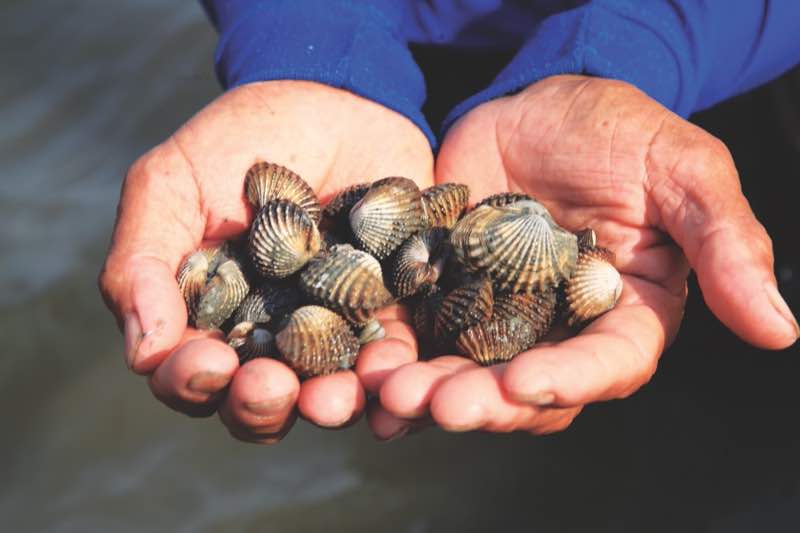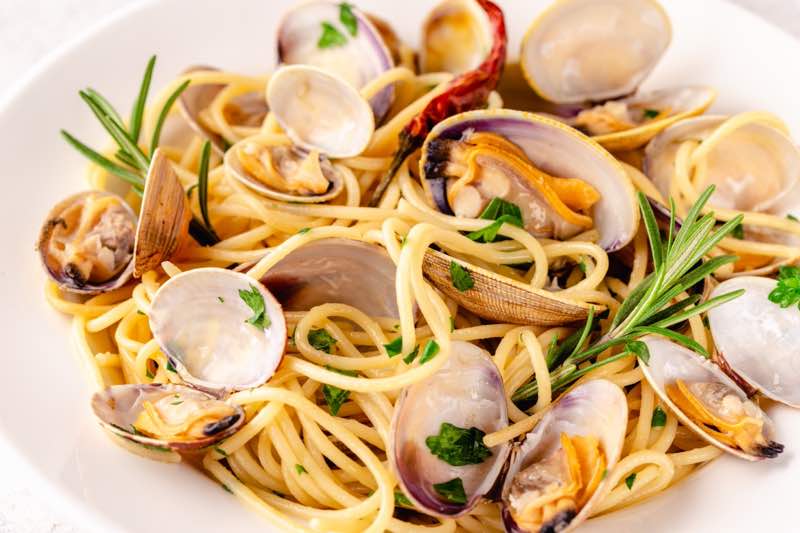Nederlands
English
Deutsch
Français
This month, besides the scallops, venus clams and vongole already covered, we want to highlight another popular shellfish − the cockle. The cockle can be regarded as the Dutch sibling of the vongole. Taste-wise, there is hardly any difference between them.
Cockles are present in various European bodies of water. However, high-quality cockles originate from our own country, namely in the Wadden Sea. The colour of cockles from the Wadden Sea differs from those from France or England. Specifically, cockles from the Wadden Sea are much greyer in colour.
Are you a buyer looking for high-quality cockles? This article will tell you all about cockles, from their origin to their appearance and the different types available. Also, discover Mooijer-Volendam’s top-quality cockles and read about cockle fishing in the Netherlands.
Topics covered in this article:
A short introduction to cockles
Cockles, like vongole, are molluscs. However, despite their many similarities, vongole and cockles belong to different families. Vongole or venus clams are bivalve molluscs belonging to the large Veneridae family. Cockles, on the other hand, is a bivalve mollusc type belonging to the Cardiidae family or Heart Shell family. The corresponding Latin name is Cerastoderma edule. Cockles from the Cardiidae family are also called ‘true cockles’ or ‘edible Heart Shell’.
Cockles are found in shallow waters (up to a maximum depth of 15 metres) along the coastlines of Europe, Asia and North America. The most famous cockles come from our own Wadden Sea, and the high quality of these cockles makes the Netherlands one of Europe’s biggest cockle producers.
Cockles have a round, skewed shell that varies in size from 2 to 6 centimetres in diameter. The colour depends on where the shell is harvested.
Cockles are very popular in cuisine and are often eaten as part of a seafood course. They can be eaten raw, sautéed, steamed or boiled and are usually served with butter, garlic and herbs.
Besides their culinary value, cockles also play an important ecological role. They help purify water in the ecosystems in which they live by filtering algae and other organic particles from the water. Cockles are also an important food source for birds; a hungry oystercatcher can eat hundreds of cockles a day!
There are several types of cockles worldwide, but the most common ones are:
The common cockle is the most well-known and widely eaten cockle variety in Europe. The Japanese cockle is an Asian cockle variety that is also widely farmed and eaten in Europe. The American cockle is a species found on the coast of North America and Canada. This article exclusively focuses on the common cockle.
The common cockle is a shell everyone has encountered on the beach. Its shell is thick and usually slightly longer rather than tall. The shells are well-filled − especially during the last months of the year. Both shell valves have a jagged edge. The common cockle looks very similar to a Lagoon cockle, and even when looking at them closely, you can hardly distinguish between the two cockle types.
Cockles are either white, greyish, yellowish brown or brown in colour, and young specimens have a mottled pattern near the top. Cockles can reach about 10 years of age. The cockle’s diet consists of plankton, algae and other food floating in the water. These little molluscs live just below the surface, buried about five centimetres in the sea bed.
The common cockle mainly comes from our own Wadden Sea. However, most cockles fished in the Netherlands for commercial fishing are exported. In Europe, the main production countries for common cockles include Spain, France, Italy, Portugal and the UK − they primarily use cockles in the world-famous tapas and paella dishes.
Cockles can be consumed all year round, but they are at their best in winter: packed shells with much meat and exceptionally tasty. The cockle stock in the Netherlands is under constant monitoring. Over the past decades, the cockle population in the Wadden Sea has experienced huge fluctuations: warm summers caused massive cockle mortality in the Wadden Sea, which led to a temporary halt in cockle fishing.
Cockles are thus very sensitive to environmental changes. But with a little help, they will always recover. For example, in order to conserve the cockle stock, permits for mechanical cockle fishing in the Wadden Sea have not been issued since 1 January 2005. Mechanical fishing no longer fits within the premise of the ecologically sustainable development of the Wadden Sea. Since then, cockles in the Wadden Sea may only be harvested manually.

Manual cockle fishermen are only permitted to harvest 5% of the cockle stock. This is usually done at low tide when the cockles are clearly visible and easier to pick. Cockle harvesting is a traditional fishing method and a very labour-intensive process. But it does come with advantages. For example, handpicking is much more environmentally friendly than other fishing methods, as no heavy machinery that could damage the seabed is used. Moreover, the cockles can be sorted according to size and quality as they are being harvested so that only the best ones are taken for consumption.
In some areas, cockles are also farmed instead of wild-caught. In the Netherlands, cockle farming is a relatively small-scale activity. Inland cockle farming is done in big shallow basins with pumped groundwater and is still largely in an experimental phase.
Hence, the harvesting of cockles is regulated to prevent overfishing. Nevertheless, it is important to know that not all cockles are safe to eat, especially if they have been collected from areas with high levels of water pollution. Therefore, as a buyer, it is very important to know where the cockles come from: whether the cockles have been obtained from areas declared safe for consumption.
All our fresh cockles at Mooijer-Volendam are always wild-caught in our Wadden Sea, where they are harvested by hand. That ensures that our cockles are high-quality, packed with flavour and undamaged. Our fresh wild cockles are available in three different sizes: medium (90/100 pieces per kilogram), large (60/80 pieces per kilogram) and extra large (40/60 pieces per kilogram). We also sell pre-cleaned cockles: ready-to-cook cockle meat that (after thawing) is ready for use.
Cockles can be regarded as the Dutch sibling of the Italian venus clam and can be prepared similarly. In terms of taste, there is hardly any difference between the two: venus clams are slightly bigger, flatter and smoother than cockles, which are ribbed. In general, cockles are slightly cheaper than venus clams, but this generally varies every year.
Gastronomically, the cockle is one of the most beautiful shellfish around. Like venus clams, mussels and other shellfish, cockles should be washed properly before cooking. When doing so, rinse them thoroughly to remove any sand residue. There are a few things you must check to make sure the cockles are fresh:
Cockles are most commonly used in dishes such as pasta with cockles, risotto with cockles, grilled cockles or cockles in white wine sauce. The most common and traditional method is to cook the cockles in a pan with a bit of oil or butter, along with garlic, onion, peppers and white wine. It is important to cook the cockles until they have opened and not longer, as overheating can affect the flavour and texture.
Besides boiling them, cockles can also be grilled, sautéed or steamed. The same applies here when cooking them: do not cook cockles for too long, as they will dry out and become tough or rubbery. In general, cockles are versatile and tasty seafood that can be prepared and served in many ways.

Did we inspire you, and would you like to start using high-quality cockles? Then you have come to the right place.
As a specialised fish wholesaler, Mooijer-Volendam sets high standards for its quality products. For this reason, we only sell responsible cockle products. This is why more and more customers choose us as their wholesaler for the catering industry or fish shops, Asian shops, speciality shops and large retailers.
Our customers are well aware of our vision on quality and keep coming back to us. Are you interested too?
Would you like to know more about our cockles available in various sizes?